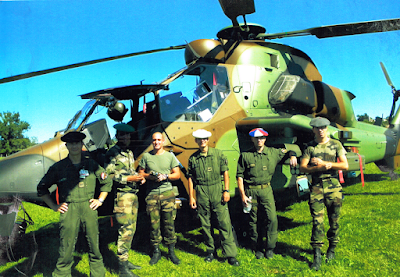Thursday, April 3, 2025
Hesteyade de Bigorre
Wednesday, April 2, 2025
ALAT - Aviation légère de l’armée de Terre

In 1912, the French military aviation was formally incorporated into the French Army, alongside the four longstanding divisions of infantry, cavalry, artillery, and engineers. As such it played important role in WWI in support of the army: observation, artillery guidance, bombing and strafing. In 1934, the aviation division turned into the French Air Force.
 |
| Helicopter Crew wearing LBF Berets |
After WWII, it was felt that, just like the navy, the army needed its own air branch, distinct from the air force, which led to ALAT's creation in 1954.
Since it has participated in almost all French military engagements and humanitarian aid deployments: the French Indochina War, the Algerian War, the Persian Gulf War of 1990–91, the Lebanese conflict, the war in Chad, the independence of Djibouti, the War in Somalia, operations in Bosnia-Herzegovina, the Kosovo War, the Indonesian occupation of East Timor, the Opération Licorne in Côte d'Ivoire, the humanitarian response to the December 2004 Indian Ocean earthquake and tsunami, the War in Afghanistan, 2011 military intervention in Libya.

The blue berets were distributed for the first time in July 1954 to the helicopter units of the Army in Indochina (GFHATI). In order to strengthen the cohesion of the GFHATI, Commander CRESPIN wanted to unify the headgear in service, by adopting a beret in "RAF blue" color. Faced with a lack of resources and the slowness of the administration, he had managed to recover, from the quartermaster's office, a stock of blue berets abandoned by the metropolitan paratroopers (NB: the latter nevertheless wore it until 1957).
It is worn tilted on the left side and does not have a rank
insignia.
Before the adoption of the ALAT-specific beret badge in
1957, personnel from certain units that already had a corps badge wore it on
their beret.
 |
| Pakol worn by ALAT members of ISAF, Afghanistan |
Since 2018, the 4th Special Forces Helicopter Regiment
(RHFS) has a new beret. The special forces regiment maintains a strong link
with the ALAT, but is now subordinate to the pillar of the Land Special Forces
Command.

The embroidered badge is composed of the wings of the
paratroopers on either side of the commandos' dagger, surmounted by the
intelligence star.
Tuesday, April 1, 2025
Dramatic Presidential Decree
WASHINGTON, D.C. — Today, in a bold move to distinguish the U.S. military from its global adversaries, President Donald J. Trump has announced a dramatic change in the U.S. Army Special Forces' iconic headgear.

Effective immediately, the Special Forces green beret will be replaced by the Basque beret, in the same shade of green, as a global symbol of strength, unity, and heritage.
%20.png)
“As we face increasingly complex threats from adversaries like China and Russia, it is imperative that our military remain distinct and unmatched in every way,” President Trump stated. “The green beret, though a proud symbol of our forces, has unfortunately been co-opted by other nations. It is time for a change. The Basque beret is unique, stylish, and can make America great again.”
Eventually, the Basque beret will become the new standard for all branches of the U.S. military, representing both an evolution in military fashion and a rejection of imitation. The President emphasized that this move would strengthen U.S. military identity on the global stage.
Sunday, March 30, 2025
Cesare Zavattini
Cesare Zavattini was an Italian screenwriter and one of the first theorists and proponents of the Neorealist movement in Italian cinema.
Saturday, March 29, 2025
The Spirit of the Beehive (El espíritu de la colmena)
The Spirit of the Beehive (El espíritu de la colmena) is a 1973 Spanish drama film directed by Víctor Erice. The film was Erice's debut and is considered a masterpiece of Spanish cinema.
Friday, March 28, 2025
Willie G.
William Godfrey "Willie G." Davidson (1933) is an American businessman and motorcycle designer, and the former senior vice president & chief styling officer of Harley-Davidson Motor Company.



Thursday, March 27, 2025
Laurita Siles from Fundación BilbaoArte Fundazioa
If only my Spanish, let alone Basque, language skills were better, I could relate here exactly what these photographers stand for. Alas, neither Spanish or Basque or my strong points.
The blackened face has to do with the carranzanas sheep; a breed at the edge of extinction.
Either way, fascinating pictures.
Wednesday, March 26, 2025
Seydou Keïta

Tuesday, March 25, 2025
Basque Anthropology/Ethnography

Monday, March 24, 2025
Tagging
Cartoon (2007) held by the New Zealand National Library:

Sunday, March 23, 2025
Prieto Manuel Benitez
(1912 - 1991) was a Spanish painter and medal sculptor.
 |
| Manolo Prieto in El-Puerto-de-Santa-María, 1929 |










































